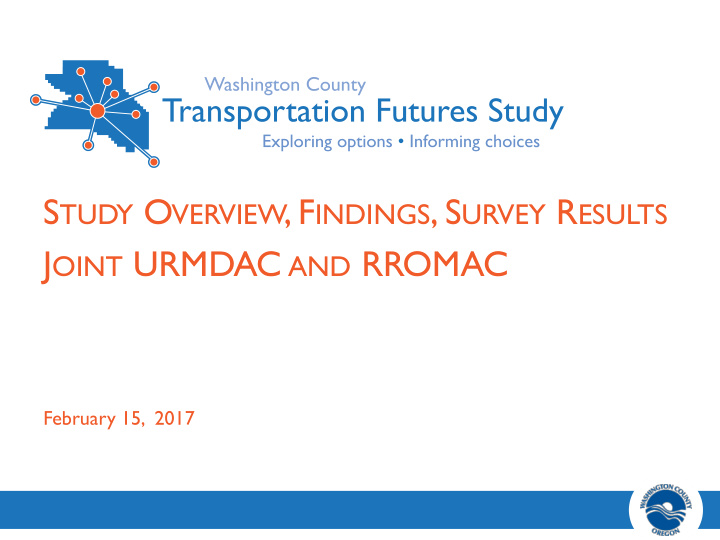



S TUDY O VERVIEW , F INDINGS , S URVEY R ESULTS J OINT URMDAC AND RROMAC February 15, 2017
2013 Legislative charge “…evaluate the long-term transportation strategies and investments needed to sustain the county’s economic health and quality of life in the coming decades”
Public process shaped study • Online open houses and community briefings Public • Advised project team throughout the study Advisory Committee • Reviewed approach and analysis Agency Coordination
Our Past: Growth and transition Grew faster than predicted Much more ethnically diverse Land use plans responded to changing community values and economic conditions Implemented transportation funding strategies
Our Future: Urban form takes hold Growth scenarios based on Local plans and 2040 Growth Concept Urban and Rural Reserves Changing demographics and technology Two scenarios Current Trends Increased Trade and Technology
More people + more jobs = more urban Population could increase 40%-55% Growth targeted to urban centers and corridors Employment could increase 100%-145% More daily trips into the county than out of the county; and the share of daily trips within the county will increase
More people + more jobs = more trips Total trips increase up to 60% Driving trips to increase by 50% Walking and biking trips increase by nearly 100% Transit trips increase by over 200%
More trips = more traffic delay and congestion 165% Longer travel times, 365% especially on freeways Vehicle hours of delay (PM Peak) % increase compared to 2010 Congested regional access points Truck hours of delay, especially on freeways, increases over four-fold More cut-through traffic
Transportation Investment Packages A. Adopted Plans, Enhanced Transit and Demand Management B. Builds upon A with an Enhanced Arterial Network C. Builds upon A with New Major Roadway and Transit Capacity
Centers + corridors = fewer vehicle trips VMT per person trip continue to decline Improved street connectivity, parking management, and commuter programs Increase non-auto use by 50% in centers More roads = more VMT
Smart technology = better efficiency and safety Increased efficiency with smart streets (signal and communications technology) Improved safety, and reliability with smart cars (connected/ autonomous vehicles) May increase VMT
More people + more jobs = more transit demand Portland transit trips more than double Transit trips within county increase by nearly 300% Transit demand increases an additional 20% with express service and park & ride 80% of households within ¼ mile of transit More than 80% of low-income households within ¼ mile
Improved arterials = better traffic distribution Improved arterial capacity, new connections and access management could: Reduce traffic delay by 5% Improve safety Shift traffic out of neighborhoods Limited freight and travel time improvement
New roads + highway capacity = reduced delay and improved travel time Reduce traffic delay up to 15% Reduce cut-through traffic in urban centers by up to 14% Improve travel times between key regional centers
New road connections = reduced regional traffic on parallel routes New Northern Northern Connector Connector : Reduces traffic on US 26, including 60% of trucks Improves travel time to North-South Limited Access PDX and I-5 Northbound Road Rural, community and environmental impacts
New road connections = reduced regional traffic on parallel routes New North-South Northern Connector Limited Access Road : Reduces traffic on TV Hwy and rural roads Improves travel time North-South Limited Access between Hillsboro and Road Clackamas County Rural, community and environmental impacts
Managed highway lanes = improved travel times • Managed lanes for trucks, transit and carpool could: Reduce delay for trucks by over 40% Increase carpooling • Demand stills exceed capacity
Pricing = reduced congestion Tolling can help better manage traffic flow BUT May increase cut-through traffic Road user charges (VMT charge) can reduce travel demand by as much as 15% IF Implemented as a variable fee - by time and location
Complete streets + trails = improved health and safety 200% increase in walking and biking Almost 80% of the households will have access to a complete street (with sidewalks and bike lanes) or a trail Protected bike lanes, trails, and complete streets improve safety and access
Relative costs Costs range from Bicycle & $11 B to $26 B Pedestrian * New revenue Transit needed Arterials Highways * Estimated costs in 2016 dollars, subject to refinement
What does the public think?
How did the County get input? O NLINE O PEN H OUSE • 5,319 People participated (Also, 42 participated in Spanish- language survey) • BIG INCENTIVE! R ANDOM S AMPLE P HONE S URVEY • Telephone survey among 400 Washington County residents age 18 years and older • Margin of error +-5%
Transportation priorities O VERALL People support a multimodal system • • Improving traffic flow is top objective O NLINE O PEN H OUSE • Ranked transit as top priority; closely followed by new freeway lanes R ANDOM S AMPLE P HONE S URVEY • Ranked roads and highways as top priority; closely followed by transit
Support for new funding sources O NLINE O PEN H OUSE • 2 out of 3 support or strongly support a gas tax, and over half support/strongly support paid parking. R ANDOM S AMPLE P HONE S URVEY 3 out of 4 people would be • willing to pay $100 per year • 48% willing to pay $300/year
Other key findings 88% expect transportation will be a problem in the future. 80% support exploring ways to use smart technologies to reduce the need for widening or building new roads Over 70% said very important to reduce freeway congestion within and connecting to Washington County 60%-70% support new limited access N-S roadways Increased support if it reduces congestion Decreased support if it increases GHG, impacts farm and forest
What’s next? • Continued review of the findings • Collect input on next steps: – Investments – Studies – Policies – Partnership
Questions
Thank you! Study Contact Information www.WCTransportationFutures.org Department of Land Use and Transportation 503-846-4530
Recommend
More recommend